A dramatic plague outbreak in Madagascar caught us unprepared just a few days before our recent trip to Africa. Apparently, it began as early as August 2017, and was spreading rapidly as the especially lethal pneumonic form. In contrast to the more common, bubonic type (which typically spreads by flees from rats and few other animal-hosts to people), pneumonic plague is transmitted from-person-to-person. By the time the news broke out, we had already made most of our Africa trip arrangements. However, as independent travelers, we had far more flexibility in shaping our upcoming vacation.
Hope for the Best, Prepare for the Worst
When facing potential health threats, like disease outbreaks, do not panic and cancel the trip right away. First, assess the situation objectively using the authoritative sources of information:
- Seek advice of the travel clinic near you
- Check with the international and national health authorities, such as World Health Organization (WHO) and Centers for Disease Control and Prevention (CDC)
- Bring your medication, personal hygiene and other health-related supplies
- Avoid high-risk activities and specific geographic locations at your travel destinations.
Through our independent research and travel clinic, we received loads of information about the disease and learned to recognize its symptoms. More importantly, we got enough antibiotics to last us through two full courses of treatment.
No Plague Vaccine, but Antibiotics are Highly Effective
Before leaving home, we visited our travel nurse to make sure we had all the necessary vaccinations and medicines for the trip. We shared out tentative itinerary with the map showing all routes and destinations.
Despite many years of basic and clinical research worldwide, there is still no safe and effective vaccine against this highly deadly infectious disease. However, several potential vaccine development approaches are being explored by scientists. Fortunately, the pathogen has remained relatively stable for hundreds of years, giving hope for successful plague prevention by vaccination. According to researches, the genetic makeup of the modern time bacteria does not seem too much different from the original plague bacteria.
Plague is highly curable with antibiotics, if detected and treated early. Moreover, drug-resistance has not been widely reported. Later during the outbreak, WHO reported that 33 isolates of Yersinia pestis had been cultured and tested by the Institut Pasteur Madagascar. All of them were sensitive to the antibiotics recommended by the National Plague Control Program. None of the 81 health care workers, who have been infected during the outbreaks died from the disease. This underscores the importance of safety measures, early disease diagnosis and access to antibiotics.
Keeping an Eye on Updates from Health Authorities
On the day of our departure to Africa, World Health Organization (WHO) reported that the death toll from the epidemic had reached 102 people. This number was surprisingly high and greatly exceeded those from the previous plague outbreaks in Madagascar. At the same time, 9 other African countries (including South Africa) were now at high alert due to a significant risk of a similar outbreak. The travel health advisories for Madagascar at CDC had changed: from “Watch Level 1, Practice Usual Precautions” to “Alert – Level 2, Practice Enhanced Precautions”.
Since Namibia was our first destination after Cape Town, we decided to keep monitoring the situation and the CDC status. Should it change to “Warning Level 3, Avoid Nonessential Travel”, we would have canceled our trip to Madagascar and visit several National Parks in South Africa instead.
History of Black Death in Madagascar
Plague was brought to Madagascar from India by boats back in 1898, as part of so called “third pandemics”. It reached the area of central highlands by 1920, where it has remained endemic ever since. Despite numerous outbreaks recorded in the major port cities, those locations do not appear to be persistent plague reservoirs in the country. Studies have shown that the costal environment hardly represents a suitable long-term ecological niche for the disease source. In many cases, the examined bacterial strains could still be traced to the highland areas. A similar route from the highlands to the coast was implicated into spreading of the latest plague outbreak of 2017.
The latest outbreak of 2017 was the pneumonic variety and was spreading throughout the major cities. Most previous occurrences were diagnozed as the bubonic type and were limited to small remote villages. The details of such a transformation of bubonic into pneumonic type of disease was described in detail: “The index case was a bubonic patient with a secondary lung infection, who contaminated a traditional healer and his family. Funeral ceremonies and attendance on patients contaminated other villagers. In total 18 cases were recorded, and eight died”.
“Turning of the bones” at Famadihana
As we were reading the news from the major media outlets, “dancing with the dead” was being “promoted” as THE REASON for the plague epidemics. They were referring to famadihana, traditional secondary burial rituals practiced by several highland tribes (mostly Imerina and Basileo). The custom, commonly known as “turning of the bones”, involves exhumation of deceased family members from the ancestral tombs. As their remains are being re-wrapped into fresh silk cloth and carried around by family members, the entire community celebrates with dancing, drinking and live music. Famadihana is based on the belief that the dead do not join the rest of their ancestors until their bodies reaches full decomposition with appropriate ceremonies and festivities.
The process could take up to several years and involves direct contact with corpses. There have been concerns that this burial practice could perpetuate the spread of plague and other diseases in Madagascar. However, firm scientific evidence to support such a connection between famadihana and the viscous cycle of the Black Death are profoundly lacking.
A large epidemiological study of plague cases in Madagascar reported that “the incidences were negligible during the period when the Famadihana tradition was presumably practiced”. Researchers believe that other environmental and anthropological factors are more likely to play a larger role in spreading the plague. The pathogen’s natural host is the black rat (Rattus rattus), which also infested the island more than a century ago. During the cool and dry season (July-December), the population of rats drops. The fleas start feeding of people, thereby, transmitting the disease and leading to regular outbreaks.
Monitoring the Outbreak Status
Upon our return from Namibia, we checked the updates issued by WHO. The outbreak appeared to had peaked in October and the number of new cases were decreasing. More than half of all cases had been reported in the capital of Antananarivo and the main port of Toamasina, the largest cities in Madagascar. The CDC had not raised their alert level and the flights from South Africa for Madagascar were leaving as scheduled. At that point, we decided to pursue our original travel plans. However, we did modify our itinerary to avoid prolonged stays in the larger cities and visits to crowded places. Quite predictably, only 18 seats (out of over a hundred) were taken on the plane bringing us from Johannesburg to Antananarivo.
Preventing the Future Epidemics
Most of our time in the country, was spent in transit and visiting national parks. We did explore some small villages, local markets and artisanal workshops in the highlands, but kept those activities to a minimum. Better safe than sorry. One early evening, we witnessed a heated discussion on the veranda of our small hotel in Ambalavao province. It was a multidisciplinary team of European health care professionals from Doctors without Borders in the middle of a brainstorming session. These were doctors, nurses and social workers tasked with educating the local population and medical personnel about plague prevention, symptom recognition and treatment.
They sounded undeterred and optimistic about finding a long-term solution to plague outbreaks in the country. As their colleagues worldwide, they passionately advocated for increased research, prevention and treatment efforts by the Malagasy authorities and the international community.

